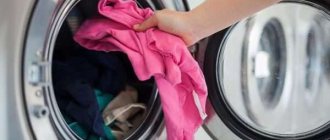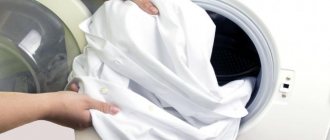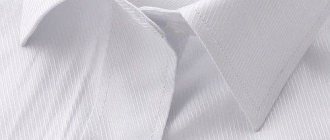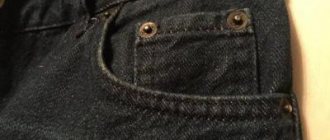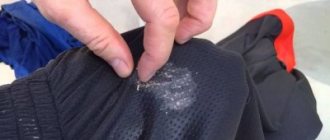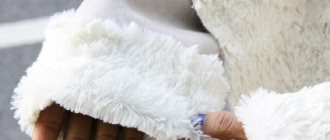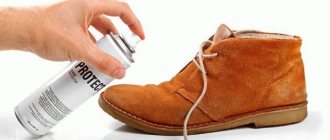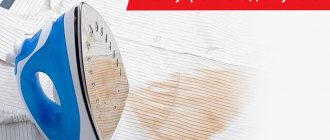If things turn a new color during washing, don’t get upset and throw them away. Indeed, today there are many ways and means to help bleach things that have been dyed during washing without harming the basic color and structure of the fabric.
Such situations occur often, especially among young housewives who are trying to do everything around the house. This is how snow-white shirts with bright socks or handkerchiefs accidentally end up in the same wash, which release dye upon contact with warm water and leave their pigment in the form of streaks and stains on light-colored clothes.
What things are painted most often?
What sheds first:
- new clothes;
- jeans;
- jackets;
- bright things, especially red, orange, green, black, brown and blue;
- synthetics.
What is most susceptible to staining when washing:
- white fabric of any composition;
- natural fabrics;
- anything that was washed with lightly dyed colored clothing.
Crystal white things should not be washed even with light beige, gray, or pink. There is always a risk of slight staining. And especially do not wash white with red and black, even if dark things have never faded before.
Important Tips
To prevent the bleaching process from causing even more damage to white items, you must take into account the following tips:
- Follow the manufacturer's recommendations indicated on the label.
- Try a new product on an inconspicuous area and monitor the tissue's reaction.
- Observe the dosage of the bleaching agent.
- Strictly follow the instructions for using the stain remover; do not leave things in it for longer than the time specified in the instructions.
- After washing, dry things properly, do not hang white and colored items on top of each other, and do not fasten them with one clothespin.
When working with aggressive compounds, you need to protect your hands with gloves and your respiratory system with a mask or respirator.
Emergency recovery
The first thing many housewives do immediately after discovering stains is to put things in the drum again. That's right, try adding more powder or gel, as well as oxygen bleach. An alternative is to rub the wet item with a bar of laundry soap and let it sit for half an hour and then wash it.
We save things depending on the type of fabric
Natural cotton and linen items can withstand hot water, powerful bleach and even boiling. But these radical methods are absolutely not suitable for synthetics and openwork products.
Tip Aggressive spinning in the drum is one of the reasons for quickly washing out paint from fabrics. Set the minimum speed. The higher the friction, the greater the risk of shedding. It is for this reason that matter of different composition and density is sorted.
Natural fabrics
First, repeat the machine wash, but with more powder. Another option is to soak in hot water and bleach. If it doesn’t help, then start boiling. This is the slow heating of a solution with a bleaching component. The procedure lasts no more than half an hour.
Synthetic fabrics
Boiling is absolutely not suitable for synthetics, and even washing in hot water will only worsen the situation. To correct staining, use cool water and a gentle bleach.
Silk, wool, delicate fabrics
Take care of wool, silk and other delicate items in the same way as synthetics. Treat expensive fabrics like cashmere like royalty: wash strictly separately and only according to the instructions on the label.
First aid
For the whitening procedure to be effective, you need to start it immediately. Waiting for the item to dry is not recommended, as this will complicate the task.
Here's what you need to do first:
- Find the “culprit” of the incident. The dyed item must be removed.
- Wash the faded linen again using powder.
- White linen should be washed in hot water (the maximum allowable value for a particular item).
- Use oxygen bleach to wash whites.
Under no circumstances should you iron faded fabric! This will lead to the “sealing” of the pigment in its fibers. It will be impossible to remove the paint.
Special equipment
If repeated washing with lots of soap or powder does not work, move on to more powerful measures. Hardware stores are pleased to offer bleaches with universal characteristics. Let's look at the most popular products and categories.
Antilin
This product is suitable for both white and colored items if they are painted with someone else’s shade. The original color is retained. Can be used for both machine and hand washing.
Bleach
A number of manufacturers from Vanish to Synergetic offer bleaches based on oxygen and optical brightening particles.
The obsolete component chlorine is still used. Products containing it are cheap, but their negative effect on materials requires increased care.
Stain remover
An alternative for dyed items is stain remover. You should not bleach pink or beige; instead of paint stains, faded areas will appear. Look for bottles marked “color.”
Powder + bleach
Some powders contain whitening granules. It is very comfortable. You can wash not only dyed items, but also ordinary ones - to prevent and preserve whiteness.
At home, try whitening methods one at a time, do not mix several types of household chemicals at once, wanting to speed up the result. Unexpected reactions are possible, and the clothes will deteriorate completely. Before trying a new product, rinse the test clothing thoroughly.
How to restore whiteness to laundry at home?
You can restore lost whiteness using folk remedies. If they are powerless, then you should use professional bleaches.
White things shed differently. Sometimes colored stains or spots appear on them, and sometimes they are completely painted in gray, pink or another shade.
How to whiten with folk remedies?
White items that have faded after washing can be restored using available products. Most often they are used according to a single scheme: “preparing the solution → soaking → washing as usual.”
The most effective means at hand that have a whitening effect:
- Baking soda. To prepare the solution you will need 5 liters of water and 6 tbsp. l. soda Soak things in the resulting solution for 4 hours.
- Laundry soap. It is grated and completely dissolved in water. The laundry is soaked in the solution for 1-2 hours.
- Vinegar. Dissolve 100 g of table vinegar in 6 liters of water. Clothes are soaked for 6 hours.
- Turpentine. For 5 liters of water you will need 5 tbsp. l. turpentine. The item is soaked in the resulting solution for 3 hours.
- Hydrogen peroxide. For 5 liters of water you will need 150 ml of liquid pharmaceutical antiseptic. The item is left in the solution for 3 hours. Peroxide is convenient to use for local stain removal. It is applied to a cotton pad and the problem area is treated.
- Ammonia. For 5 liters of water you will need 1 tbsp. l. alcohol The item is soaked for an hour.
- Starch and lemon juice. They are mixed in such a way that a thick paste is obtained. It is applied to the fabric and left to act for 12 hours.
- Potassium permanganate. Several potassium permanganate granules need to be completely dissolved in warm water. The water should be pinkish. The holding time is 2 hours.
- Lemon acid. Dissolve 2 tbsp in 5 liters of water. l. powder. Things are soaked for 2 hours.
- Aspirin. 5 tablets are dissolved in 5 liters of water. They must first be crushed into powder. Things are soaked in the solution for 8 hours.
- Mustard. Dissolve 5 tbsp in 5 liters of water. l. mustard powder. Things are soaked for 2 hours.
- Lemon juice. It is applied to the stain in its pure form. The exposure time is 2 hours. This product is used to remove local stains.
- Boric acid (alcohol solution 3%). Dissolve 2 tbsp in 3 liters of water. l. acids. Things are soaked for 60 minutes.
- Tooth powder or white clay without additives. The selected composition is diluted with water until a thick paste is obtained. It is applied to the stain, left for 30 minutes, after which the laundry is washed as usual.
Before starting the procedure, you need to make sure that the fabric can withstand exposure to high temperatures. To do this, study the information indicated on the product label.
How to boil white things correctly:
- take a large enamel pan, fill it with water (the container should be clean and without signs of rust);
- 1 kg of laundry will require 10 liters of water;
- heat water, dissolve 250 g of liquid laundry soap and the same amount of soda in it;
- put the laundry in water and leave it to boil;
- Things need to be stirred periodically;
- Recommended cooking time is 1-1.5 hours.
After boiling, the water is drained, the laundry is cooled and rinsed in cool water.
How to save things using household chemicals?
Faded items can be washed using bleach. Scheme of their use:
- dissolve the composition in water;
- soak clothes;
- wash as usual.
Top 3 effective remedies:
- Antiline from Frau Schmidt. This bleach and stain remover is sold in tablets. For a pack of 10 pieces you will have to pay about 230 rubles. You can buy 2 tablets for 60 rubles.
To process 1 kg of laundry, 1 piece is enough. It is dissolved in 10 liters of water (temperature from 30 to 60 degrees), washing powder is not required. After an hour, the items are rinsed and normal washing begins.
- Vanish Gold crystal white. To remove stains, it is better to purchase a gel. For a 0.45 liter package you will need to pay about 150 rubles. Dissolve 1 cap of detergent (60 ml) in 5 liters of water. Soaking time – up to 6 hours.
- Organic bleach Sodasan. The liquid concentrate does not contain chlorine. Its cost is 470 rubles. The product is applied to the stains and left to act for 30-60 minutes. Then wash the clothes in a machine, to which 30 ml of bleach is added.
Therefore, preference is given to modern household chemicals containing active oxygen. Such compositions are effective even at low water temperatures.
Traditional methods
Often, improvised products turn out to be no worse than expensive bleaches. The main thing is to apply them on time and in the right concentration. Just follow the recommendations for the type of fabric.
White
We recommend avoiding “Whiteness”, as it weakens the fibers and, if overused, causes grayness and deformation.
The product will come in handy if thick natural fabrics made of cotton, such as sheets, are heavily dyed and cannot be cleaned with anything. This chlorine bleach is used for soaking in cold water. “Whiteness” disinfects fabrics and removes greasy stains - a nice bonus.
How to restore snow-white color:
- Use protective gloves; chlorine corrodes the skin of your hands.
- For 4 l - 1 tbsp. l. "Whiteness." This is a soaking solution and lasts 15 minutes.
- Rinse clothes thoroughly afterwards.
Boric acid
Boric acid will save the most delicate white items if they have become dyed during washing. Take 1 tbsp. l. acid per 2 liters of water.
This is the best way to soak socks, T-shirts, baby clothes and underwear. Boric acid destroys fungus - a useful property for fabrics that cannot be washed in hot water.
Laundry soap + boiling
In the first case, after an unsuccessful wash, we urgently rubbed the entire fabric with a bar. Give laundry soap a second chance if your thick cotton item is damaged:
- Grate the block.
- Pour water into a pan, add soap, stir.
- Place the dyed item in the solution and start heating it slowly.
- Boil over low heat for 20-30 minutes, stirring constantly.
- Let the solution cool slightly and remove the clothes. Hot water pulled the paint out of the fibers; all that was left was to rinse thoroughly.
Vinegar
Now it's time for delicate fabrics. Colorless table vinegar, strengthened with laundry soap, will quickly restore the white color:
- For 5 liters of water - 3 tbsp. l. vinegar and some soap shavings.
- Soak for a convenient time, possibly overnight.
Soda
Prepare the following solution: for every liter of water - 1 tbsp. l. soda Let the item sit in the warm mixture for several hours, and then wash it again, this time without dyeing fabrics.
Turpentine
Treatment with turpentine will prevent new cotton items from fading and losing their brightness. For 1 liter - 10 ml of product. Soak for half an hour. The same solution will be useful if things are painted.
Hydrogen peroxide
Peroxide will save any T-shirt, since, in fact, it is an oxygen bleach:
- For 4 liters of water - a 50 ml bottle of hydrogen peroxide.
- You can add washing powder.
- Soak affected clothing for an hour, then wash.
Tip Peroxide is suitable for boiling: 3 tbsp per pan is enough. l.
Ammonia
For 6 liters of water - 1 tbsp. l. ammonia. Immerse the painted fabric in the solution for half an hour.
Starch
Previously, housewives regularly starched white collars, sheets and other things. If you mix potato starch, lemon juice and a little grated laundry soap, and then treat the stains from the inside out, then after a couple of hours the usual whiteness of the fabric will be restored. The method is suitable for synthetics.
Potassium permangantsovka
The French way to whiten things:
- The solution is only slightly concentrated. A few permanganate crystals are enough for a basin of water so that the water is barely colored.
- Add powder and soak the item.
- Don't forget to rinse. An extra wash won't hurt.
Lemon juice
This citrus is useful not only for colds, but also for emergency treatment of faded items, including delicate items, wool and silk. Simply squeeze the juice out of the fruit and apply it to the stain from the inside out. After 1 hour, rinse, usually this time is enough to remove the paint.
Advice: Lemon juice is replaced with a solution of citric acid - 15 g per glass of water.
What you need to restore color to dyed clothes
Stock up on the items listed below. Perhaps you will find some things in your home arsenal, but others will have to be purchased:
- Ammonia (ammonia solution);
- Vinegar;
- Hydrogen peroxide (perhydrol);
- Soda;
- Salt;
- Lemon acid;
- Potato starch;
- Black tea;
- Black mascara;
- Laundry soap.
Exactly which ingredients from the list you will need depends on what fabrics and colors you will be working with. For bleaching or tinting, different compositions are needed. So before you go shopping, check out the ways to restore faded items.
How to prevent staining
Preventing staining of fabrics is easier than removing stains. This is a truism familiar to every housewife. Especially the one who had to urgently bleach stains from her clothes.
Sorting
This is the basic rule. We sort not only by color (white, light, different colors, black), but also by the composition of the material. Natural linen with synthetics cannot be washed.
We wash new items separately
Introduce new clothes to water and powder as carefully as possible and separately from other things: we don’t know how the fabric will behave. The examination can be carried out in a separate small area. Wet the edge of the fabric with warm water and see what happens.
Temperature
Even items washed several times can suddenly fade due to hot water. It's simple: the higher the washing temperature, the easier the paint particles are washed out.
Wash certain items by hand
Inspect the details of the clothing carefully: even stripes, pocket lining or collars may fade, leaving stains on lighter areas. Treat such items in cold water and quickly; do not soak them for a long time.
Note color fixing tricks: vinegar and salt solution for pre-soaking. Special washing conditioners will help restore the brightness and color of dyed clothes.
Tip How to wash a black dress with a white collar: soak the item briefly in soapy water, wash, rinse and wring out. Then lay it out on a flat surface and apply the bleach solution strictly to the collar. After 15-20 minutes, rinse the dress completely again and send to dry.
We use bleach
Such products best restore natural materials; synthetics interact with the active substances of bleaches somewhat more difficult. To whom, in the case of artificial tissues, the desired result may not be achieved. The main rule when choosing bleach is to give preference to products containing oxygen. They are characterized by a soft and at the same time effective action.
For hand washing, it is better to pre-soak clothes in bleach for 6-8 hours. Then wash and rinse. Machine washing requires special care and is only permissible if the tag on the dress or other clothing does not contradict this. Try not to use powder bleaching products in the machine; the gel has a more gentle effect and is no less effective. Before use, dilute the product in a small amount of water, pour it into the conditioner compartment and set it to multiple rinses.
For dense fabrics, local treatment of stained areas can be applied. Apply the cleaning compound liberally to the moistened stain and lightly wash. Then leave it in the aqueous solution for 5-10 minutes and wash it in the usual fabric mode with thorough rinsing.
